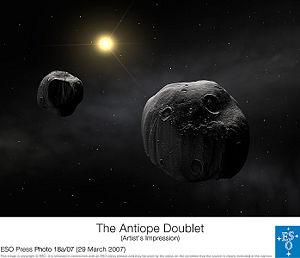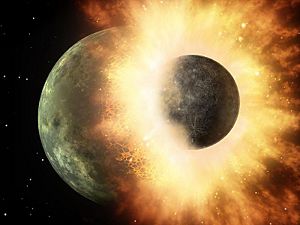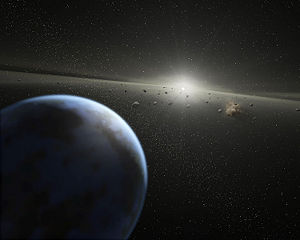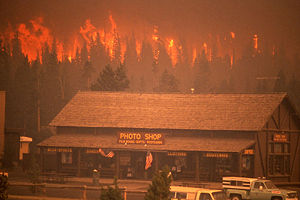2012 doomsday prophecy
The 2012 doomsday prophecy was a prediction that the world would end, based on irrational fears fueled by certain booksellers, fearmongers, moviemakers and other hucksters to encourage public panic for the purpose of making money. The hoax used dubious claims about astronomy and ancient Mayan calendars to promote nonsensical predictions regarding apocalyptic events supposed to occur on December 21st or 23rd of 2012. Doomsayers suggested there will be destruction caused by global floods, solar flares, exploding sun, reversals of the magnetic field, or planetary collisions.[1][2] Many people were scared.[3][4]
Scientists agree 2012 doomsday forecasts are "bunk".[5][6]
The 2012 doomsday pop culture phenomenon was similar in many respects to the "Y2K" phenomenon which marked New Year's Eve in 1999, when the new millennium happened. The hysteria has also been compared to the panic created by Orson Welles radio program War of the Worlds. But the "2012 apocalypse business is booming", according to the Huffington Post. The 2012 doomsday prediction was one more example of a pattern repeated over the centuries; for example, Baptist preacher William Miller convinced perhaps a hundred thousand Americans that the second coming of Jesus Christ would happen in 1843; it didn't. Doomsday predictions tend to be within the span of about ten years from the present, according to University of Wisconsin historian Paul Boyer, since the sense of "imminence" and that it will "happen soon" is necessary for these hysterias to catch the public imagination.[3]
- This article relates to year 2012 doomsday predictions.
- For information on '2012, the movie', see 2012 (film).
- For a knowledge base relating to the year, 2012, see 2012 CE.
Mass hysteria fed by pop culture
What characterized the doomsday phenomenon was how it was built around the ancient Mayan mathematical calendar. A reporter for USA Today wondered "how the ancient Maya got dragged into all this?" Mayan calendar systems were complex and circular; Mayans believed every 25,000 years or so that "time would come to an end and would start over".
This factoid enabled pseudo-scientific "scholars" such as John Major Jenkins, who drew attention to the Mayan calendars, to reportedly jump-start the hysteria craze. It is not clear whether Jenkins is, in fact, the originator of the hysteria, but clearly he was one of the originators of speculation concerning the Mayan calendars. Jenkins is not a trained archaeologist but is a "self-described Maya scholar" who became convinced that there will be a galactic alignment of the Earth, sun and Milky Way on or near December 21, 2012. His book Maya Cosmogenesis 2012, published in 1998, claimed that the Maya predicted this alignment. Jenkins suggested that this alignment might have some kind of "transformative effect on Earth". His publishing success led to more books.[1]
In 2006, the book 2012: The Return of Quetzalcoatl sold thousands of copies each month, and helped build the idea of 2012 as a doomsday year into a kind of pop culture phenomenon. It built on popular interest after Mel Gibson's film about the Maya civilization called Apocalpyto. Successful book sales led to imitators; within a few years there were several books on the market dealing with the theme of 2012 being the year of the apocalypse. The books built on superstition that somehow the Maya's "Long Count" calendar marks the end of a 5,126-year era, and suggested that this calendar was somehow able to predict events far into the future.[7]
A few of the books were:
- 2012: The Return of Quetzalcoatl by Daniel Pinchbeck (2006). This author predicted a "change in the nature of consciousness," assisted by indigenous insights and psychedelic drug use.[8]
- 2013 Oracle: Ancient Keys to the 2012 Awakening by David Carson & Nina Sammons (2006)
- Apocalypse 2012: A Scientific Investigation Into Civilization's End by Lawrence Joseph (2007). A journalist predicted an apocalypse.
- The Revolution of 2012: Vol. 1, The Preparation by Andrew Smith(2007). Smith is a supposed "spiritual healer", and he predicted a "restoration of a true balance between Divine Feminine and Masculine".
- Serpent of Light by Drunvalo Melchizedek (2007)[7]
As the pop culture fear-mania kept growing, people who fueled this speculation saw that they could make lots of money by writing books or making movies. A bandwagon effect emerged. A senior religion editor at Publishers Weekly, Lynn Garrett thought the 2012 buildup echoed excitement and fear similar to the mass hysteria experienced on the eve of the new millennium known as "Y2K". To make money, publishers seem to be "courting readers who believe humanity is creating its own ecological disasters and desperately needs ancient indigenous wisdom." The appeal of the "earth religions" resonates with concerns about the environment.[7]
The popular hysteria fueled by unscrupulous doomsday sayers kept growing despite the efforts of scientists to check it. Scientists saw the 2012 doomsday scenarios as a "complete fabrication" and a chance for many people to cash in on the craze. There were no connections between the ancient Maya and contemporary spirituality. Maya civilization flourished for centuries between AD 300 and AD 900, and disappeared mysteriously, but Maya excelled at math and astronomy and developed a way to track time called the "Long Count calendar" which was discontinued during Spanish rule. But the end of a 5,000 year cycle was not a way to forecast the end of time, but rather was a marker indicating a cause for celebration.[7]
Anthropologist Susan Gillespie from the University of Florida wrote:
| ‘ | ...the 2012 phenomenon comes "from media and from other people making use of the Maya past to fulfill agendas that are really their own.[7] | ’ |
By November 2009, the hysteria was inflamed by movies and books on the subject: what will happen on December 21, 2012? A reporter from the Dallas Morning News predicted that 2012 would have a "carnival" type feeling that it was "Y2K" all over again, and explained:
| ‘ | Movies are pushing it, television shows are plotting it, books and Web sites have sprung from its fertile soil. The subject: Dec. 21, 2012. That's the day, according to people pointing to an ancient Mayan calendar, either the world will come to an end or the universe will witness a grand transformation toward peace and harmony. This philosophy is getting a lot of attention, thanks to ancient beliefs and astronomy and New Age religion – all hyped by anxiety over global warming. Of course, this includes a blockbuster movie, 2012, which opens Friday.[9] | ’ |
There were shows on the cable television History Channel about 2012 speculation.
Ratcheting hysteria with movies
The movie 2012 had the premise that the ancient Mayans predicted a world cataclysm in the "winter solstice in 2012".[10] As the $200 million thriller,[1] it was dubbed "end of the world disaster porn" by Time Magazine critic Richard Corliss, and has been used by conspiracy theorists to spur a "swelling industry of doomsday books and TV shows." In the movie, the lunar or "lunatic" prophecies come true. What happens in the movie? A New York Times reporter explained the sequence of events:
| ‘ | In the movie, an alignment between the Sun and the center of the galaxy on Dec. 21, 2012, causes the Sun to go berserk with mighty storms on its surface that pour out huge numbers of the elusive subatomic particles known as neutrinos. Somehow the neutrinos transmute into other particles and heat up the Earth’s core. The Earth’s crust loses its moorings and begins to weaken and slide around.Los Angeles falls into the ocean; Yellowstone blows up, showering the continent with black ash. Tidal waves wash over the Himalayas, where the governments of the planet have secretly built a fleet of arks in which a select 400,000 people can ride out the storm.[6] | ’ |
To promote the movie, Sony Pictures set up a "fake website" called "The Institute for Human Continuity" which was "crowded with scientific-sounding content about the coming end of the world" which "encouraged people to sign up for a lottery to be 'saved' before the end". By 2009, total sign-ups numbered (supposedly) 14 million.[1]
The film's director and co-writer Roland Emmerich also worked on other Hollywood disaster films such as Independence Day, The Day After Tomorrow, and was described by Corliss as the "king of disaster porn" whose films "kill off billions of humans so that one family can get back together." The movie features earthquakes, meteor showers, and a tsunami which dumps an aircraft carrier on the White House.[5]
But evidently, despite the movie being a movie, some people have been described as "scared". There have been errant beliefs that the Mayan calendar supposedly "runs out" on December 21, 2012, but a Mayan Indian elder insists that this is not the case. But panic has caused astronomers to get e-mails from fourth graders saying "they're too young to die." But archaelogists, astronomers, and Maya Indians say the only thing likely to hit Earth is a "meteor shower of New Age philosophy, pop astronomy, Internet doomsday rumors and TV specials such as the one on the History Channel." There were reports that the numbers of books about 2012 numbered into the hundreds.[6]
Lorne Dawson, an expert on doomsday cults and a sociology professor, explained that belief in a doomsday cult can provide "hope, inspiration, satisfaction" to people who haven't quite succeeded in life.[9]
What caused the panic? At an obscure archaelogical site in southern Mexico during the 1960s there was a stone tablet found which had the equivalent of the date 2012 on it. The barely legible inscription describes something that is supposed to occur in 2012 involving a mysterious Mayan god named Bolon Yokte who is associated with both war and creation, but the end of the passage is "almost illegible." An archaelogist from Mexico's National Autonomous University interprets the last eroded glyph as saying "He will descend from the sky."[5]
The panic was a "booming business" which led people to buy survival kits, and watch documentaries and buy books on the subject. There were countless web sites adding to concerns. There are reports that some teenagers were considering suicide because "they didn't want to be around when the world ends", and women considering killing their children "so they wouldn't have to suffer through the end of the world."[3]
Conspiracy theorists added a new twist to the hysteria by insisting that world governments and those "in power" know about the impending disaster, but do nothing to save us. Such theories are easily spread by web sites on the Internet which don't have reputations to uphold, or need review from collegues, unlike the scientific or academic world. Rather, web sites can say whatever they wish if it encourages more people to visit their site. Benjamin Radford of the science magazine Skeptical Inquirer wrote:
| ‘ | With the Internet it's easier than ever for misinformation to fly around the world, spreading panic. It's the democratization of information: Any nut job who thinks the end of world is coming in 2012 can set up a website to push that.[1] | ’ |
Some actions by governments have not helped end the hysteria. For example, the government of Norway in 2008 opened a "seed vault" to protect seeds in the event of a natural disaster such as an earthquake or nuclear strike which is dug "deep into the permafrost" and stores 4.5 million seed samples from around the world to shield them from climate change.[11] The Svalbard Global Seed Vault built the facility for $9 million and allows other countries to store seeds for free, and withdraw them upon need, and has giant air conditioners to keep seeds frozen so they can last for 1,000 years. The vault is designed to withstand earthquakes. But actions like Norway's can be interpreted by conspiracy theorists as "evidence" that governments know about the doomsday scenario, and are preparing for it.
But the hysteria affected many people. ABC News reported that a man named Patrick Geryl from Belgium quit his job and founded a "survival group" to cope with the "catastrophe that he knew was coming." He got water purifiers, dust masks, vegetable seeds, wheelbarrows with spare tires. Geryl explained: "You have to understand, there will be nothing, nothing left ... We will have to start an entire civilization from scratch." Geryl is planning to buy a plot of land high up in the mountains of Africa to withstand the "monstrous tidal waves" and wait out the "volcanic dust" which will block out the sun.[4]
Scientists try to calm the hysteria
Essays in The New York Times tried to debunk the hype and hysteria, quoting scientists from both the United States of America and Europe as saying the fears were groundless. Essayist Dennis Overbye asked "How often do you have a pair of such blue-ribbon scientific establishments assuring us that everything is fine?" referring to the United States National Aeronautic and Space Administration (NASA) and the European Center for Nuclear Research (CERN).[6] Scientists were trying to allay concerns that "a black hole would be spit out of its new Large Hadron Collider and eat the Earth."[6]
Astronomers said it's all "bunk". Ed Krupp, director of the Griffith Observatory in Los Angeles said:
| ‘ | Most of what’s claimed for 2012 relies on wishful thinking, wild pseudoscientific folly, ignorance of astronomy and a level of paranoia worthy of Night of the Living Dead.[6] | ’ |
Writer Anne Hill in the Huffington Post wondered why the Maya couldn't predict their own demise.[12] In her essay in 2009 entitled "Why 2012 Predictions are Really Stupid", Hill wrote: "I simply cannot believe that in three years the Mayan calendar will fall off a shelf and change the world as we know it." The Mayan civilization disappeared around 900 AD and there has been no definitive account of why this happened, and no evidence that the Mayans could foretell their own civilization's collapse.[12]

Astronomer David Morrison was getting 20 letters and e-mails daily from "people as far away as India" who were "scared out of their wits", and he described himself as angry that "people are being manipulated and frightened to make money ... There is no ethical right to frighten children to make a buck." Morrison tried to explain the hysteria in this way:
| ‘ | We are always uncertain about the future, and we always consume representations of it. We are always lured by the romance of the ancient past and by the exotic scale of the cosmos. When they combine, we are mesmerized.[6] | ’ |
- Sun aligning with the galactic center. There's nothing special about this since it happens every December.[6]
- Collision with another planet. If another planet were heading our way, "everybody could see it by now", according to scientists. Scientists at NASA claim that planet "Nibiru" doesn't exist. NASA scientist Morrison set up a website called "a 2012 FAQ" to debunk doomsday scenarios. There had been speculation that the so-called Planet Nibiru was supposed to hit the Earth in 2003; it didn't.[2]
- Fierce solar storms. The next sunspot maximum won't happen until 2013 and will be "on the mild side" according to astronomers.[6]
- Magnetic poles flipping. Scientists report this happens every 500,000 years and is a natural phenomenon. "There's no reason to think it will happen now (and) no reason to think it will cause a problem if it did," according to NASA scientist Dr. Morrison.[2]
- Dark rift. This is just a place where there are dust clouds in the Milky Way. Morrison said: "I can't imagine where someone decided to be afraid of that."[2]
Further, reports suggest that unethical doomsayers have seriously distorted what the Mayans believed. There is no evidence the Mayans thought anything special would happen "when the odometer rolled over on this Long Count in 2012".[6]
According to one report, scientists were becoming alarmed at the 2012 alarmism. The U.S. National Aeronautical and Space Administration or NASA has denounced the whole 2012 hysteria phenomenon as an "Internet hoax" on its website.[1]
Further, present day Mayans, descended from the ancient Maya, were growing tired of the phenomenon. Mayan elder Apolinario Chile Pixtun said he was "fed up with this stuff" and was reportedly "tired of being bombarded with frantic questions about the Mayan calendar supposedly running out on December 21, 2012."[13]
After the Predicted Date Had Passed
Once the wide-spread fear of the end had passed, many people were relieved that the Earth was still intact. Many people had traveled to the ruins of Mayan cities for the predicted demise of the world and celebrated their survival when they realized they were fine. [14] Others had traveled to a Turkish town called Sirince with the belief that it would be spared from the apocalypse. [15] Doomsday believers traveled to a variety of places they believed were safe depending on which manner they believed the world would end in, then celebrated the apparent survival of civilization. Some doomsday believers were relieved that there was no apocalypse and moved past their beliefs. Other doomsayers began worrying about a future apocalypse; they theorized that previous analyses of the Mayan calendar had been incorrect and that the real date of the destruction would be in the near future [16] Over a decade after the expected end, the fear of these predictions have faded, and doomsday believers fear other events rather than the unclear destruction predicted by the Mayan calendar.
References
- ↑ Jump up to: 1.0 1.1 1.2 1.3 1.4 1.5 Maria Puente. Oh, Maya! Is 2012 the end? Film boosts doomsday frenzy, USA Today, 2009-11-12. Retrieved on 2010-03-14.
- ↑ Jump up to: 2.0 2.1 2.2 2.3 Scared Of Planet Nibiru? NASA Would Like To Help, NPR, November 15, 2009. Retrieved on 2010-03-14.
- ↑ Jump up to: 3.0 3.1 3.2 Brian Handwerk. 2012 Prophecies Sparking Real Fears, Suicide Warnings, Huffington Post, National Geographic News, 2009-11-10. Retrieved on 2010-03-14.
- ↑ Jump up to: 4.0 4.1 CHRISTINE BROUWER. Will the World End in 2012?, ABC News, July 3, 2008. Retrieved on 2010-03-14.
- ↑ Jump up to: 5.0 5.1 5.2 Mark Stevenson, Associated Press. Scientists debunk 2012 as doomsday date, San Francisco Chronicle, October 11, 2009. Retrieved on 2010-03-14.
- ↑ Jump up to: 6.0 6.1 6.2 6.3 6.4 6.5 6.6 6.7 6.8 6.9 DENNIS OVERBYE. Is Doomsday Coming? Perhaps, but Not in 2012, The New York Times, November 16, 2009. Retrieved on 2010-03-14.
- ↑ Jump up to: 7.0 7.1 7.2 7.3 7.4 G. Jeffrey MacDonald. Does Maya calendar predict 2012 apocalypse?, USA Today, 2007-03-27. Retrieved on 2010-03-14.
- ↑ DWIGHT GARNER. The End Is Near! Now the Good News: It Could Be Groovy, The New York Times: Books, February 5, 2009. Retrieved on 2010-03-14.
- ↑ Jump up to: 9.0 9.1 November 10, 2009. Fueled by Mayan legend, movies and books speculate on what will happen Dec. 21, 2012, Dallas Morning News, November 10, 2009. Retrieved on 2010-03-14.
- ↑ Richard Corliss. 2012: End-of-World Disaster Porn, Time Magazine, Nov. 12, 2009. Retrieved on 2010-03-14.
- ↑ "Doomsday" Seed Vault Opens In Norway -- Arctic Vault Protects Millions Of Seeds From Climate Change, War, Natural Disasters, CBS News, Feb. 25, 2008. Retrieved on 2010-03-14.
- ↑ Jump up to: 12.0 12.1 Anne Hill. Why 2012 Predictions are Really Stupid, Huffington Post, January 12, 2009. Retrieved on 2010-03-14.
- ↑ Mayan Elder Tired of 2012 Queries, CBS News, Oct. 12, 2009. Retrieved on 2010-03-14.
- ↑ Alexandra Alper. World survives as Maya 'end of days' marked in Mexico, Reuters, Dec. 21, 2012. Retrieved on 2023-11-03.
- ↑ Mayan Apocalypse 2012: Sirince, Turkish Village, Flooded By Doomsday Believers, HuffPost, Dec. 11, 2012.
- ↑ Stephanie Pappas. After Mayan Apocalypse Failure, Believers May Suffer, Live Science, Dec. 22, 2012.



